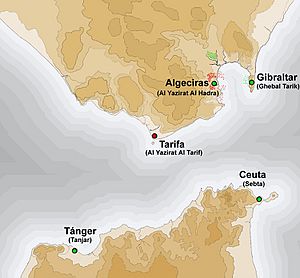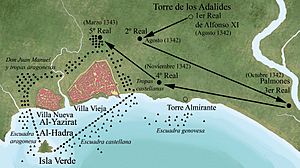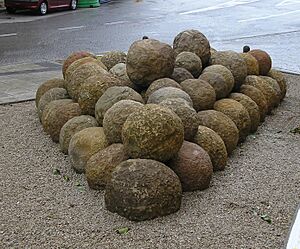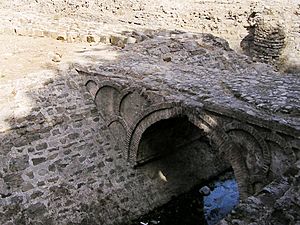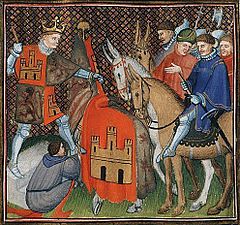Siege of Algeciras (1342–1344) facts for kids
Quick facts for kids Siege of Algeciras (1342–1344) |
|||||||
|---|---|---|---|---|---|---|---|
| Part of the Battle of the Strait during the Reconquista | |||||||
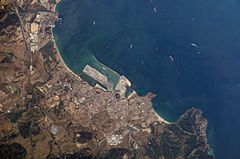 Satellite pictures of Algeciras |
|||||||
|
|||||||
| Belligerents | |||||||
| Commanders and leaders | |||||||
The Siege of Algeciras was a long battle that took place from 1342 to 1344. It was part of the Reconquista, a period when Christian kingdoms in Spain fought to regain control from Muslim rulers. King Alfonso XI of Castile led the Christian forces. He had help from ships from the Kingdom of Aragon and the Republic of Genoa.
Their goal was to capture the Muslim city of Al-Jazeera Al-Khadra, which Christians called Algeciras. This city was very important. It was the main port for the Marinid Empire in Europe. The siege lasted for 21 months. About 30,000 people lived in the city, including soldiers and civilians. They suffered from a blockade by land and sea, which stopped food from entering.
The Emirate of Granada sent an army to help Algeciras, but it was defeated near the Río Palmones. Because of this, Algeciras surrendered on March 26, 1344. It then became part of the Crown of Castile. This siege was also special because it was one of the first times gunpowder was used in battles in Europe.
Why the Siege Happened
The Threat from Muslim Forces
Algeciras used to be part of the Emirate of Granada. But in 1329, the King of Morocco took control of the city. He made it the capital of his lands in Europe. In 1333, forces from Granada and Morocco took back the nearby city of Gibraltar.
In 1338, Abd-Al-Malik, the son of the King of Morocco, led raids against Christian lands in southern Spain. He was the ruler of Algeciras and Ronda. During one of these raids, Castilian soldiers killed him. His body was taken back to Algeciras and buried there.
Abd-Al-Malik's father, Abu al-Hasan Ali ibn Othman, crossed the strait in 1340. He defeated a Spanish fleet and landed in Algeciras. At his son's grave, he swore to defeat the Castilian king. He then laid siege to the town of Tarifa.
King Alfonso XI of Castile was worried about these new North African forces. He feared losing Tarifa. So, he gathered an army with help from King Afonso IV of Portugal. The two armies, Christian and Muslim, fought near Tarifa in the Battle of Río Salado on October 30, 1340. The Muslims lost this battle. This made Alfonso XI realize he needed to capture Algeciras. It was the main port where troops from Africa entered Spain.
Getting Ready for Battle

Starting in 1341, King Alfonso XI began preparing his army for the siege. He ordered new ships to be built. He also got help from the Genoese fleet, led by Egidio Boccanegra. Fleets from Portugal and Aragon also joined.
On land, besides his Castilian troops, he had soldiers from Aragon. Many European crusaders also came to help. Even the kings of England and France supported him. To pay for the war, a special tax was put on all goods sold.
In 1342, Alfonso XI met with his admirals. He learned that the Aragonese fleet was heading to Algeciras. He then went to Getares Cove, about 3 kilometers from the city. There, he checked his galleys (warships). The admiral told him they had stopped ships carrying food to Algeciras. They had also fought 80 Muslim galleys, capturing 26 of them. The rest fled to African ports.
The Castilian knights thought this was the perfect time to surround the city. They believed Algeciras had limited supplies. However, the king felt he still didn't have enough troops. Most of his soldiers were still in Jerez de la Frontera, waiting for his orders. The defenders of Algeciras already knew the Christian army was coming.
The king returned to Jerez and held a meeting. He ordered his admirals to stop any boats trying to supply Algeciras. He also told his scouts to capture anyone from Algeciras who could give them information about the city. His knights advised him on the best places to set up camp and where to attack the city's defenses.
On July 25, 1342, Alfonso XI left Jerez with his troops. Many important officials and knights joined him. These included archbishops, bishops, and leaders of military orders. Councils from several cities also sent their support.
On August 1, the Christian troops arrived at Getares. There were 1,600 mounted soldiers and 4,000 archers and lancers. The armies and fleets from Aragon, Genoa, and Castile took their positions.
On August 3, the main headquarters were set up on a hill north of Algeciras. The king stayed in a tower there during the first months. This tower, called the Torre de los Adalides (Tower of the Champions), offered a great view of the Muslim city and the roads to Gibraltar.
Inside Algeciras
Al-Jazeera Al-Khadra was the first city founded by Muslims in Spain in 711. In the 1300s, the city had two separate parts, each with its own walls. The Río de la Miel flowed between them. The river's mouth formed a natural harbor, protected by Isla Verde (Green Island).
The northern part, Al-Madina, was called Villa Vieja ("old town") by the Spanish. It was the oldest part, founded in 711. It had strong walls, towers, a deep moat, and a protective outer wall. The main entrance, the Fonsario, was near the city cemetery. This gate was the weakest point, so it was the most heavily defended.
The southern part, Al-Binya, was called Villa Nueva ("new town"). It was built by the Marinids in 1285. It was on a high area that used to be a Roman industrial zone. Its steep sides helped its defense, so it didn't need walls as strong as Villa Vieja. Villa Nueva held the fortress and the main troops. Algeciras had about 800 horsemen and 12,000 archers. The total population was around 30,000 people. This information came from captives taken by the Castilian king.
The Siege Begins
Early Days: August to October 1342
From August 3, 1342, after setting up camp, King Alfonso XI ordered his engineers to plan troop positions. The main goal was to stop troops from leaving the city and prevent reinforcements from Gibraltar. The plan was to starve Algeciras into surrender, rather than attacking it directly.
There were many small fights between the two armies. One morning, 300 cavalry and 1,000 foot soldiers from Algeciras attacked a part of the Christian lines. A German count and his men charged forward too soon. The Muslim soldiers pretended to retreat, then counterattacked. The count was killed, and his companions were saved only when Spanish allies arrived.
After seeing the danger, the king ordered a trench dug around Villa Vieja. This trench went from the Río de la Miel to the sea. It was meant to stop attacks from the city. Shelters were built along the trenches, and soldiers guarded them at night. The king moved his headquarters closer to the city. He also sent men to capture the Cartagena Tower. From there, they could watch the Marinid movements from Gibraltar.
In September 1342, the Aragonese fleet left the siege. This was because a war was about to start between Aragon and the Kingdom of Majorca. Siege engines were sent near the city's northwest gate. Two large towers there protected the defenders. While these machines were being built, some defenders attacked from the Puerta de Xerez to stop their placement.
The Algecireños tried to trick the besiegers into coming closer to the walls. Many Christian knights, not used to this type of border warfare, died in these early months. In one raid, the king's equerry (a royal attendant) and other important men were killed.
The siege continued, and the King of Castile sent men to ask for help. The Archbishop of Toledo went to meet the King of France. Another leader went to see the new Pope, Clement VI.
The besiegers faced more problems than expected. In early October, a huge storm hit. The camp in the northwest turned into a swamp. The defenders used this confusion to attack at night, causing much damage. The floods forced the headquarters and most troops to move to the mouth of the Palmones River. They stayed there for the rest of October 1342. Soon after the Christian camp moved, the Algecireños launched a desperate attack from Villa Vieja. They reached the new Christian camp and killed many knights.
First Winter: November 1342 to April 1343
Conditions got worse for both sides. Food was scarce in the Christian camp after the flooding. Crowded troops and animals led to diseases spreading. In November, Aragon sent ten galleys, and Portugal sent another ten. But the Portuguese ships stayed for only three weeks, which boosted the defenders' spirits. The Castilian forces struggled to keep enough ships for supplies and attacks. However, Algeciras started running out of food due to the sea blockade.
In the first months, the Spanish kept launching rocks at the city walls. The defenders used weapons like ballistae, which shot large projectiles. In December 1342, more troops arrived from Castile. The siege became tighter. Many Genoese ballistic engines were placed around the city. The defenders continued to shoot arrows at those setting up the machines.
By January 1343, constant fighting weakened both sides. A large wooden tower, called a bastida, was built facing the Puerta del Fonsario. From this tower, missiles could be shot over the city wall. The first bastida was burned by a force from the city. But another was built and kept firing at the city throughout the siege.
Yusuf I, Sultan of Granada, was preparing to send supplies to Algeciras. With this threat, attacks on the Puerta del Fonsario increased. This was the weakest but best-defended point. Alfonso XI ordered new covered trenches built there. These allowed soldiers to get closer to the walls to place siege engines. From Algeciras, defenders fired iron projectiles from early bombards (cannons) using gunpowder. These caused a lot of damage. They are believed to be the first cannons used in Spain.
Trenches were built around the entire city by March 1343. Behind the trenches were earth banks, with wooden walls and strong towers to protect the soldiers. Trebuchets in the Castilian camp threw many stone balls, called bolaños. These trebuchets could throw stones up to 300 meters. So many bolaños were used that in 1487, King Ferdinand II of Aragon sent an expedition to Algeciras to collect them for another siege.
More Christian troops arrived, replacing injured or weak soldiers. In February 1343, the besiegers began to block the sea approaches to the city. They aimed to stop food from Gibraltar. They tried to block the sea with logs connected by chains. This barrier stretched from the south of the city to Isla Verde, and then to the north. However, in late March 1343, a storm broke the barrier. The logs washed ashore, giving the besieged city useful wood.
Reinforcements Arrive: May to September 1343
In May 1343, a large army led by the Sultan of Granada crossed the Guadiaro River and moved towards Algeciras. Alfonso XI called his knights to discuss how to deal with this new threat. He sent letters to Granada, offering to lift the siege if they paid him tribute. The Sultan of Granada offered a truce, but it wasn't enough for the Castilians.
That same month, many European knights arrived. From England came the earls of Derby and Salisbury. From Germany came Count Bous. From France came Gaston II, Count of Foix, and his brother. King Philip III of Navarre also arrived with supplies and troops.
The troops from Granada held their position, waiting for the right moment to approach the city. In June and July, the situation remained the same. More fortified siege towers and trenches were built. Fighting continued around the city. The defenders used ballistae and "thunders" (gunpowder bombards). These caused major damage to the siege forces, especially targeting the towers and trenches.
In August 1343, while Castile and Granada were still talking, news arrived. King Abu al-Hasan Ali ibn Othman of Morocco was preparing a fleet to help Algeciras. With forces from Granada and Morocco about to join the fight, the Christians needed to capture Algeciras quickly.
Alfonso XI also heard good news. The Pope would give his kingdom 20,000 florins for the campaign. The King of France would provide 50,000 florins. This money would help pay the Genoese mercenaries, who had been asking for their pay. The Christians' difficulties were known throughout the kingdom. The King of Castile even had to pawn his crown and melt down some silver items to get money. This happened after a fire destroyed the camp's flour supply.
At the same time, Aragon sent new ships. These joined 15 Castilian ships led by Admiral Egidio Boccanegra. They were sent to Ceuta to damage the Moroccan fleet. The Moroccan king was waiting there for the Granada fleet before going to Algeciras. In their first encounter, the Christians tried to surprise the Muslim fleet. They sent only the 15 Castilian ships into battle. The Aragonese ships pretended to help the Moroccans. This trick would have worked, but the Moroccans captured a Castilian sailor who warned them. The ships from Ceuta quickly returned to port. The Christian fleet had to go back to the Bay of Algeciras. Boccanegra then sent 20 of his ships to Getares. They were ready to stop the Moors if they attacked the siege lines.
Moroccan Troops Cross the Strait: October to November 1343
In October 1343, the Moroccan fleet crossed the Strait of Gibraltar and reached Getares. Christian lookout fires warned the army. Forty Castilian and Aragonese ships took positions at the city's southern entrance. But the North African boats did not head to Algeciras. Instead, they took shelter in the nearby port of Gibraltar.
A battle between the galleys seemed likely. The Genoese squadron began loading their equipment onto their ships to leave. Admiral Egidio Boccanegra told the king they would leave if they weren't paid four months of back wages. It was known that the Genoese sailors had been dealing with the Marinids of Gibraltar and Ceuta. Their relationship was not hostile. The Christian leaders feared that if unpaid, the Genoese soldiers might help the Muslims, as had happened before.
The king decided to pay the Genoese soldiers from his own money. The soldiers then agreed to continue the siege and stay loyal. Loans from Genoese merchants to the King of Castile also helped calm the soldiers' complaints. The two fleets did not fight in the bay. The Sultan of Morocco's ships docked in Gibraltar. They left a large number of soldiers there: 40,000 infantry and 12,000 horsemen, according to some records.
In November, the Sultan of Granada and the Prince of Morocco moved to the bank of the Río Palmones. Moroccan ships protected their movement from Gibraltar to the Palmones. They stood in the middle of the bay to stop the Christian fleet from landing troops. The Castilian command then tried to set fire to the enemy ships. They used vessels filled with flammable material and burning arrows, helped by a strong east wind. The Muslims avoided the fire by putting wet sails on deck and using long poles to push away the enemy ships.
The Christian command had been warned of the troops' arrival by signals from the Tower of Champions. The Muslim army sent a small group across the river to scout the Castilians. Alfonso XI ordered his men not to attack until all Muslim troops had crossed the river. The Muslims also knew the land. After a quick look and a small skirmish, they returned to their side of the river. They were not in a hurry to fight, as they expected reinforcements from their capital soon.
Battle of the River Palmones: December 1343
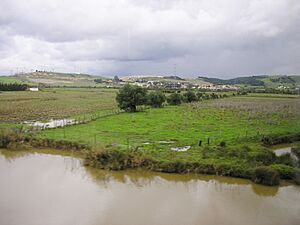
On December 12, 1343, the attacks on the city walls were very strong. The city used "thunder" (cannons) to bombard the Christian camp. In return, the Christians fired many arrows at the defenders. Shortly after dawn, Christian siege weapons made a break in the defenses. An attack was launched, but the besiegers could not get through. At this point, the defenders of Algeciras panicked. They made smoke signals from the main mosque's tower, showing their situation was desperate. At the Granada camp, they saw the signals, heard the noise, and understood the city was under attack.
The Moorish troops from Gibraltar quickly moved to join those fighting near the Río Palmones. From the Tower of the Champions, Alfonso XI directed his army. Don Joan Núñez was placed where the river could be crossed near the mountains. Muslim troops crossing the ford had to fight the Spanish. They were overwhelmed by the large number of Christian troops. Under the King's command, all Christian troops crossed the river. They chased the retreating Moorish forces.
The Muslim cavalry was quickly defeated. The Moors fled in disorder, ignoring orders to retreat to Gibraltar. Many fled to the mountains of Algeciras, others towards the Almoraima tower. The Castilians pursued them.
The combined forces of Granada and Morocco had been defeated. But the Río Palmones marshes held many bodies from both sides. It was not a complete defeat, and the Muslims might reorganize. The Christians needed the city to fall soon.
Blockade and Surrender: January to March 1344
After the bad defeat at the River Palmones, the Sultan of Granada wanted to prepare another attack. But his troops' morale was low. The Moroccan Sultan's messenger convinced him to try to make peace with the King of Castile. A letter was sent to the Christians at Algeciras offering a truce. But Alfonso XI would only accept peace if the city became part of his kingdom.
In January 1344, Alfonso decided to rebuild the naval blockade. Small boats from Gibraltar often broke through it. The new barrier was made of strong ropes supported by floating barrels. These were held in place by ship masts weighted with millstones. The masts stuck out several meters from the sea. Building this barrier took two months. During this time, small boats still managed to get through sometimes. In January, the Muslims sent a ship with supplies, but it was captured. Another attempt in February was successful. On February 24, five boats reached Algeciras with food. But by early March, the passage of boats into Algeciras was completely cut off. It was now only a matter of time before hunger forced the city to surrender.
By March, the city's situation was desperate. There was no bread or other food. There were only enough defenders to cover part of the wall. On Sunday, March 2, Hazán Algarrafe, sent by the King of Granada, arrived with news for the King of Castile. The King of Granada was ready to surrender the city. His conditions were simple: everyone in the city could leave safely with their belongings. There would be a 15-year truce between Castile and the Muslim kingdoms. Granada would also pay an annual tribute of 12,000 gold coins to Castile.
The king's knights suggested continuing the siege. They knew reinforcements would soon arrive from Seville and Toledo. The trenches around the city meant it would soon starve. However, Alfonso XI did not want to keep fighting. The cost was too high in both money and lives. He accepted the conditions, but changed the truce to only ten years. The Treaty of Algeciras was then signed, ending 21 months of siege.
On March 26, 1344, the people of Villa Nueva moved to Villa Vieja, giving Villa Nueva to Prince Don Juan Manuel. The next day, Villa Vieja was handed over to King Alfonso XI, empty of its people. The city's towers were decorated with the banners of the king and other nobles. The king's main commanders were there, including Egidio Boccanegra. He was given the title Lord of the Estado de la Palma for his work. The next day, a mass was held in the city's mosque. It was made into a cathedral dedicated to Santa Maria de La Palma, who is still the city's patron saint. An Arab historian wrote that Alfonso treated the Muslim generals and people who left the city well. Many of them moved across the bay to Gibraltar, increasing its population.
Several Castilian nobles died during the siege. These included Rui López de Rivera, Diego López de Zúñiga y Haro, and Gonzalo Yáñez de Aguilar.
What Happened Next
The fall of Algeciras was a very important step in the Reconquista. It gave the Crown of Castile the main port on the northern coast of the Strait of Gibraltar. To help the new Castilian city grow, King Alfonso XI offered farmland and tax benefits in 1345. He added "King of Algeciras" to his titles. He also asked Pope Clement VI to move the Cathedral of Cádiz to Algeciras. This created the diocese of Cadiz and Algeciras. The city's main mosque became a cathedral dedicated to the Virgen de la Palma. Algeciras then became the main base for Christian armies.
After losing Al-Jazeera Al-Khadra, Gibraltar was the only remaining Muslim port in Spain. All efforts of the Reconquista then focused on taking Gibraltar. In 1349, Alfonso XI began the fifth siege of Gibraltar. Again, he relied on the fleets of Aragon and Genoa, which used Algeciras as their main base. But this time, the city's fate was not decided by battle. On March 26, 1349, the king died during an epidemic of bubonic plague in the Castilian camp.
The king's unexpected death led to a civil war among those who wanted the Castilian throne. This quickly affected Algeciras. In 1369, during the war between Peter the Cruel and his brother Henry II, the city's soldiers were reduced. Some troops were sent north. Muhammed V, Sultan of Granada, took this chance to recapture Al-Jazeera Al-Khadra. The Muslims rebuilt the defenses and put a large force there.
The city's fate changed again when the fighting in Castile ended. In 1379, Christian armies regrouped. The Moors realized they could not defend the city if another siege happened. They also feared it falling back into Castilian hands. So, that year, they destroyed the city themselves. They tore down the harbor walls and burned all buildings. In three days, Algeciras was completely destroyed. It remained in ruins until the British took Gibraltar in 1704. Then, some people exiled from Gibraltar settled in the empty fields of the former Villa Vieja.
|
See also
 In Spanish: Sitio de Algeciras (1342-1344) para niños
In Spanish: Sitio de Algeciras (1342-1344) para niños


